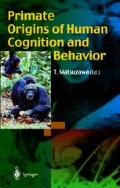Abstract
Memory is extremely important to our everyday activities. We cannot recognize, plan, or decide even a trivial issue unless we can hold information in mind for periods of time and retrieve it from our memory. This is also the case in nonhuman animals. Thus, it is not surprising that research on animal memory has a long history (Hunter 1913; Tinklepaugh 1928), as well as research on human memory (Ebbinghaus 1885).
Access this chapter
Tax calculation will be finalised at checkout
Purchases are for personal use only
Preview
Unable to display preview. Download preview PDF.
References
Asano T, Kojima T, Matsuzawa T, Kubota K, Murofushi K (1982) Object and color naming in chimpanzees (Pan troglodytes). Proc Jpn Acad 58(B):118–122
Baddeley A (1994) The magical number seven: still magic after all these years? Psychol Rev 101:353–356
Bahrick HP (1970) A two-phase model for prompted recall. Psychol Rev 77:215–222
Biro D, Matsuzawa T (1999) Numerical ordering in a chimpanzee (Pan troglodytes): planning. executing, and monitoring. J Comp Psychol 113:178–185
Cowan N (2001) The magical number 4 in short-term memory: a reconsideration of mental storage capacity. Behav Brain Sci 24:87–185
Craik FIM, Tulving E (1975) Depth of processing and the retention of words in episodic memory. J Exp Psychol Gen 104:268–294
D’Amato MR (1973) Delayed matching and short-term memory in monkeys. In: Bower GH (ed) The psychology of learning and motivation, vol 7. Academic Press, New York
Ebbinghaus H (1885) Memory. Duncker, Leipzig
Fujita K, Matsuzawa T (1990) Delayed figure reconstruction by a chimpanzee (Pan troglodytes) and humans (Homo sapiens). J Comp Psychol 104:345–351
Gardner RA, Gardner BT (1969) Teaching sign language to a young chimpanzee. Science 165:664–672
Gathercole SE (1999) Cognitive approaches to the development of short-term memory. Trends Cogn Sci 3:410–419
Gillan DJ, Premack D, Woodruff G (1981) Reasoning in the chimpanzee. I. Analogical reasoning. J Exp Psychol Anim Behav Process 7:1–17
Grant DS (1984) Rehearsal in pigeon short-term memory. In: Roitblat HL, Bever TL, Terrace HS (eds) Animal behavior. Erlbaum, Hillsdale
Hauser MD (2000) Homologies for numerical memory span? Trends Cogn Sci 4:127–128
Hunter WS (1913) The delayed reaction in animals and children. Behavior Monographs, 2, No. 1
Kawai N (2000) Relationship between transitive inference and comprehension of ordinality by chimpanzees (original in Japanese with English summary). Cognitive Studies: Bulletin of the Japanese Cognitive Science Society 7:202–209
Kawai N, Matsuzawa T (2000a) A conventional approach to chimpanzee cognition. Response to M. D. Hauser. Trends Cogn Sci 4:128–129
Kawai N, Matsuzawa T (2000b) Numerical memory span in a chimpanzee. Nature 403:39–40
Kawai N, Matsuzawa (2001) “Magical number 5” in a chimpanzee. Behav Brain Sci 24 (in press)
Luck SJ, Vogel EK (1997) The capacity of visual working memory for features and conjunctions. Nature 390:279–281
Maki WS, Hegvik DK (1980) Directed forgetting in pigeons. Anim Learn Behav 8:567–574
Matsuzawa T (1985). Use of numbers by a chimpanzee. Nature 315:57–59
Matsuzawa T (1989) Spontaneous pattern construction in a chimpanzee. In: Heltne PG, Marquardt LA (eds) Understanding chimpanzees. Harvard University Press, Cambridge, pp 252–265
Miller GA (1956) The magical number seven plus or minus two: some limits on our capacity for processing information. Psychol Rev 101:343–352
Murorushi K (1997) Numerical matching behavior by a chimpanzee (Pan troglodytes): subitizing and analogue magnitude estimation. Jpn Psychol Res 39:140–153
Roitblat HL (1980) Codes and coding processes in pigeon short-term memory. Anim Learn Behav 8:341–351
Tinklepaugh OL (1928) An experimental study of representative factors in monkeys. J Comp Psychol 8:197–236
Tomonaga M, Matsuzawa T, Itakura S (1993) Teaching ordinals to a cardinal-trained chimpanzee (original in Japanese with English summary). Primate Res 9:67–77
Urcuioli PJ Zentall TR (1986) Retrospective coding in pigeons’ delayed matching-to-sample. J Exp Psychol Anim Behav Process 12:69–77
Woodruff G, Premack D (1981) Primitive mathematical concepts in the chimpanzee: proportionality and numerosity. Nature 293:568–570
Wright AA (1999) Visual list memory in capuchin monkeys (Cebus apella). J Comp Psychol 113:74–80
Wright AA, Santiago HC, Sands SF, Kendrick DF, Cook RG (1985) Memory processing of serial lists by pigeons, monkeys, and people. Science 229:287–289
Author information
Authors and Affiliations
Editor information
Editors and Affiliations
Rights and permissions
Copyright information
© 2008 Springer
About this chapter
Cite this chapter
Kawai, N., Matsuzawa, T. (2008). Reproductive Memory Processes in Chimpanzees: Homologous Approaches to Research on Human Working Memory. In: Matsuzawa, T. (eds) Primate Origins of Human Cognition and Behavior. Springer, Tokyo. https://doi.org/10.1007/978-4-431-09423-4_11
Download citation
DOI: https://doi.org/10.1007/978-4-431-09423-4_11
Publisher Name: Springer, Tokyo
Print ISBN: 978-4-431-09422-7
Online ISBN: 978-4-431-09423-4
eBook Packages: Springer Book Archive

